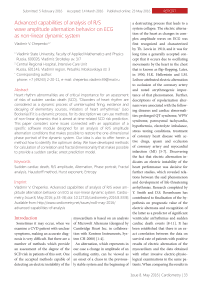Advanced capabilities of analysis of r/s wave amplitude alternation behavior on ECG as non-linear dynamic system
Автор: Chepenko Vladimir V.
Журнал: Cardiometry @cardiometry
Рубрика: Report
Статья в выпуске: 8, 2016 года.
Бесплатный доступ
Heart rhythm abnormalities are of critical importance for an assessment of risks of sudden cardiac death (SCD). “Disorders of heart rhythm are considered as a dynamic process of uninterrupted firing, existence and decaying of elementary sources, initiators of heart arrhythmias.”(Leo Bockeria) If it is a dynamic process, for its description we can use methods of non-linear dynamics that is aimed at time-related SCD risk prediction. This paper considers some issues connected with an application of a specific software module designed for an analysis of R/S amplitude alternation conditions that makes possible to restore the one-dimensional phase portrait of the dynamic system. Our idea is also to offer herein a method how to identify the optimum delay. We have developed methods for calculation of correlation and fractal dimensionality that makes possible to provide a sudden cardiac arrest prediction model.
Sudden cardiac death, r/s amplitude, alternation, phase portrait, fractal analysis, hausdorff method, hurst exponent, entropy
Короткий адрес: https://sciup.org/148308813
ID: 148308813 | DOI: 10.12710/cardiometry.2016.8.3338
Список литературы Advanced capabilities of analysis of r/s wave amplitude alternation behavior on ECG as non-linear dynamic system
- Armoundas AA, Rosenbaum DS, Ruskin JN, Garan H, Cohen RJ. Prognostic Significance of Electrical Alternans Versus Signal Averaged Electrocardiography in Predicting the Outcome of Electrophysiological Testing and Arrhythmia-Free Survival. Heart. 1998;80:3 251-6.
- Arnold J. (Cambridge Heart CEO). Personal interview. November 18, 1998.
- Predescu D, Mitruţ P, Giuca A. Microvolt T wave alternans (MTWA) -a new non-invasive predictor of sudden cardiac death. Romanian journal of internal medicine. 2004;42(3):647-56.
- Yap YG, Aytemir K, Mohan N, et al. Values of T wave alternans, QT dispersion and principal component analysis ratio in patients with idiopathic dilated cardiomyopathy. Heart. May 1999;81(1):P6.
- Fernandez-Jimenez R, Vivas D, García-Rubira JC, et al. Profound myocardial ischemia associated to occlusion of the right coronary artery. International Journal of Cardiology. 16 June 2011;149(3):e123-4.
- Arcebal AG, Lemberg L. Electrical alternation. Heart and Lung: Journal of Acute and Critical Care. 1983;12(4):456-60.
- Fel'd BN. Significance of the changes in the excitability of the myocardium in the genesis of electrical alternation and ventricular extrasystole in myocardial infarct. Kardiologiya. July 1970;10(7):66-70.
- Rosenbaum DS, Jackson LE, Smith JM, et al. Electrical alternans and vulnerability to ventricular arrhythmias. New England Journal of Medicine. 27 January 1994;330(4):235-41.
- Estes III NAM, Michaud G, Zipes DP, et al. Electrical alternans during rest and exercise as predictors of vulnerability to ventricular arrhythmias. American Journal of Cardiology. November 1997;80(10):1314-8.
- Pruvot, E.J., Rosenbaum, D.S. T-wave alternans for risk stratification and prevention of sudden cardiac death. Current Cardiology Reports. Volume 5, Issue 5, September 2003, Pages 350-357.
- Pruvot EJ, Schlaepfer J, Graf D, et al. Prevention of sudden cardiac death with T-wave alternans analysis. Medecine et Hygiene. 18 February 2004;62(2470):367-74.
- Mamberger KK, Makedonsky DF, Rudenko MY, Rudenko SM. Criteria of sudden cardiac death development. Izvestiya SFedU. Engineering Sciences. 2009;96(7):20-3.
- Rudenko MY, Voronova OK, Zernov VA. Theoretical fundamentals of heart cycle phase analysis. Munchen, London, New York: Fouque Literaturverlag; 2009.
- Rudenko MY, Zernov VA, Voronova OK. Study of hemodynamic parameters using phase analysis of the cardiac cycle. Biomedical Engineering. 2009;43(4):151-5.
- Voronova OK, Zernov VA, Kolmakov SV, Mamberger KK, Makedonsky DF, Rudenko MY, Rudenko SM. Cardiac cycle phase analysis in accurate measurement of volume hemodynamic parameters by indirect method. Policlinika. 2008;6:56-8.
- Kronover R. Fractals and chaos in dynamic systems. Мoscow: Tehnosfera, 2006.
- Jens Feder. Fractals. Publisher: Springer; 1988 DOI: 10.1007/978-1-4899-2124-6
- Kuznetsov AA. Entropy analysis of parametric series of electrocardiograms. Engineering Physics. 2011;5:28-34.
- Kuznetsov AA. Measurement characteristics and properties of information entropy of heart rhythm diagrams. Measurement Techniques. 2011;54(7):838-45.
- Kuznetsov AA, Novosel'sky PA, Chepenko VV. Entropy model of heart dynamic structure. New medical technologies. Saint Petersburg: SPGU. 2001. 27 p.
- Ott E. Strange attractors and chaotic motions of dynamical systems. Reviews of Modern Physics. 1981;53(4):655-71.
- Wagner CD, Nafz B, Persson PB. Chaos in blood pressure control. Cardiovascular Research Volume. March 1996;31(3):380-7
- Goranitou GS, Chrissos DN. Non-linear dynamical systems and chaos: Analysis techniques and applications in cardiology. Hellenic Journal of Cardiology. 1995;36(4):400-16.
- Goranitou GS, Chrissos DN, Harissis HV, et al. Nonlinear analysis of ECG in normal subjects and acute myocardial infarction patients. Annals of Noninvasive Electrocardiology. 1998;3(2):139-46.
- Grassberger P, Procaccia I. Characterization of strange attractors. Physical Review Letters. 1983;50(5):346-9.
- Elbert T, Ray WJ, Kowalik ZJ, et al. Chaos and physiology: Deterministic chaos in excitable cell assemblies. Physiological Reviews. January 1994;74(1):1-47.
- De La Fuente IM, Martinez L, Aguirregabiria JM, Veguillas J. R/S analysis in strange attractors. Fractals. June 1998;6(2):95-100.
- Shuster G. Deterministic chaos. Introduction. Moscow: Mir, 1988. 240 p.
- Isakov RV, Kuznetsov AA, Sushkova LT. Evaluation of degree of proximity of lethal arrhythmias by the nonlinear dynamics method. Biomedical technologies and radioelectronics. 2004;3:46-50.


